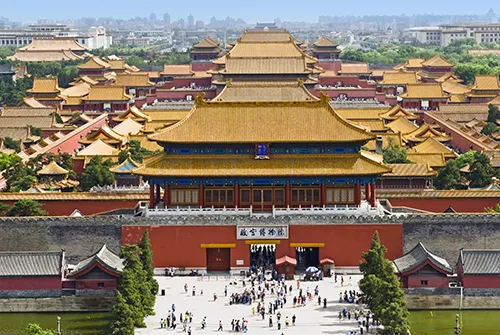
The Forbidden City (紫禁城, Zǐjìnchéng) is one of the most iconic landmarks in China and the world. Located in the heart of Beijing, this vast palace complex served as the political and ceremonial center of the Chinese empire for nearly 500 years. Declared a UNESCO World Heritage Site in 1987, the Forbidden City is not only a masterpiece of Chinese architecture but also a living testimony to the country’s rich history and culture.
Today, the Forbidden City, officially known as the Palace Museum, attracts millions of visitors annually. It offers travelers a glimpse into imperial life, ancient Chinese design, and priceless cultural relics.
History of the Forbidden City
Construction of the Forbidden City began in 1406 under the Ming Dynasty’s Yongle Emperor and was completed in 1420. It remained the imperial palace for 24 emperors during both the Ming and Qing Dynasties until the abdication of the last emperor, Puyi, in 1912.
The name “Forbidden City” comes from the fact that access was strictly limited—commoners were forbidden from entering without permission. Today, it stands as a symbol of China’s glorious past and has transformed into one of the world’s most visited museums.
Architectural Marvel
The Forbidden City covers an astonishing 180 acres and consists of about 980 surviving buildings with more than 8,700 rooms. It is surrounded by a 10-meter-high wall and a 52-meter-wide moat, symbolizing both power and protection.
Key architectural highlights include:
-
Meridian Gate (Wu Men): The main entrance, where imperial announcements were made.
-
Hall of Supreme Harmony (Taihe Dian): The largest and most important hall, where coronations and state ceremonies took place.
-
Hall of Central Harmony (Zhonghe Dian): A resting place for the emperor before ceremonies.
-
Hall of Preserving Harmony (Baohe Dian): Used for banquets and imperial examinations.
-
Imperial Garden: A beautifully landscaped space for the royal family to relax.
Every building in the Forbidden City follows principles of feng shui and traditional Chinese symbolism. Red walls represent happiness and good fortune, while golden roofs symbolize imperial authority.
Cultural Treasures of the Palace Museum
Today, the Forbidden City houses the Palace Museum, one of the largest cultural institutions in the world. It contains more than 1.8 million artifacts, including:
-
Ancient paintings, calligraphy, and scrolls
-
Ceramics and porcelain masterpieces
-
Jade carvings and bronzeware
-
Imperial seals and clothing
-
Rare books and documents
These collections offer a deep insight into China’s dynastic history, arts, and craftsmanship.
Visiting the Forbidden City: What to Expect
1. Main Attractions Inside
-
Outer Court: Used for state ceremonies and official functions.
-
Inner Court: Where the emperor and his family lived.
-
Treasures Gallery: Displays imperial jewelry and rare relics.
-
Clock and Watch Gallery: Showcases timepieces from around the world gifted to emperors.
2. Visitor Experience
Exploring the Forbidden City usually takes 3–4 hours, though history enthusiasts may spend an entire day. Audio guides and English-language tours are available, making the visit engaging and informative.
3. Best Time to Visit
The Forbidden City is open year-round, but the best seasons are spring (April–May) and autumn (September–October) for comfortable weather. Mornings are less crowded, making it ideal for photos.
Tips for Travelers
-
Buy Tickets in Advance: Tickets must be purchased online with real-name registration. Daily visitor numbers are capped at 80,000.
-
Wear Comfortable Shoes: The complex is vast, and you will be walking a lot.
-
Plan Your Route: Focus on key halls and exhibitions if short on time.
-
Photography: Allowed in most areas, but flash photography is restricted in exhibitions.
-
Combine with Tiananmen Square: Located right outside, making for a perfect half-day itinerary.
Nearby Attractions
-
Tiananmen Square: The largest public square in the world, a symbol of modern China.
-
Jingshan Park: Located directly north, offering the best panoramic view of the Forbidden City.
-
Beihai Park: A historic lakeside garden perfect for a relaxing stroll.
Why the Forbidden City Should Be on Your Bucket List
The Forbidden City is more than an architectural wonder—it is a journey through the heart of Chinese civilization. From its grand halls to its intimate gardens, it reflects the culture, artistry, and philosophy of dynastic China.
Whether you’re fascinated by history, architecture, or simply looking to stand in awe of one of humanity’s greatest creations, the Forbidden City is a destination that should not be missed.

You must be logged in to post a comment.